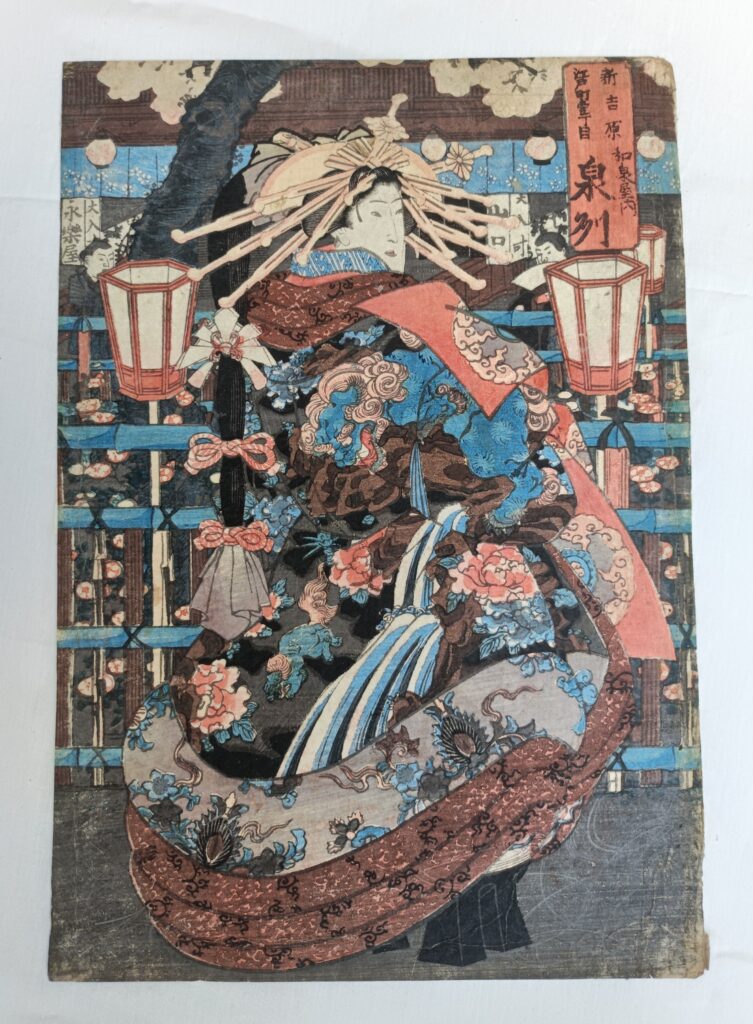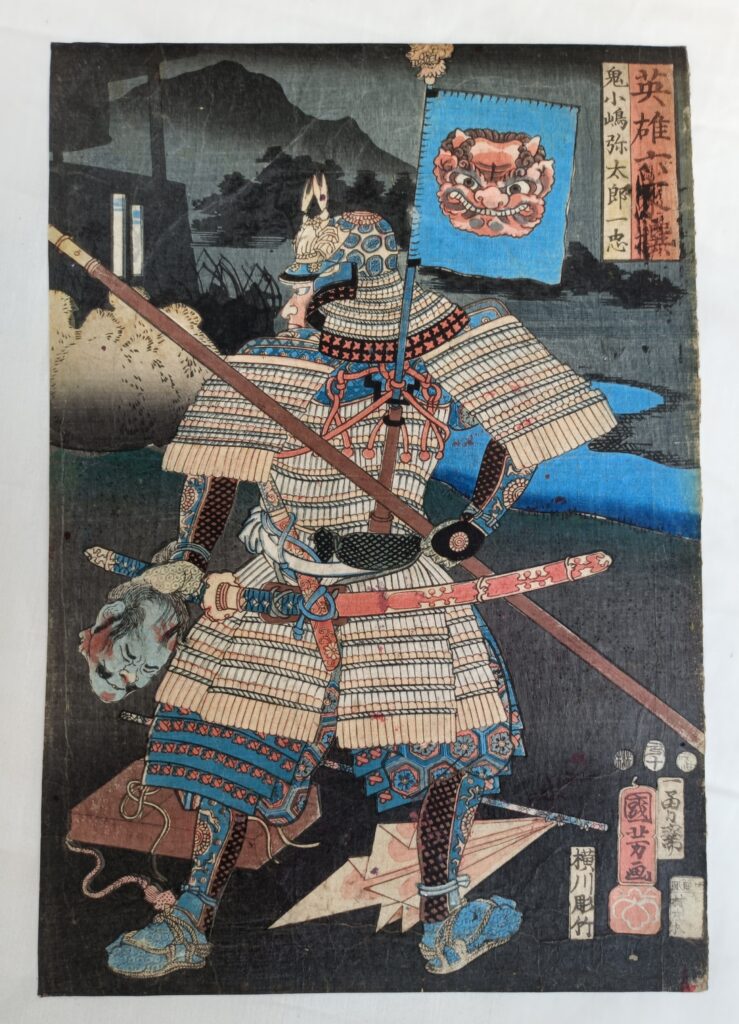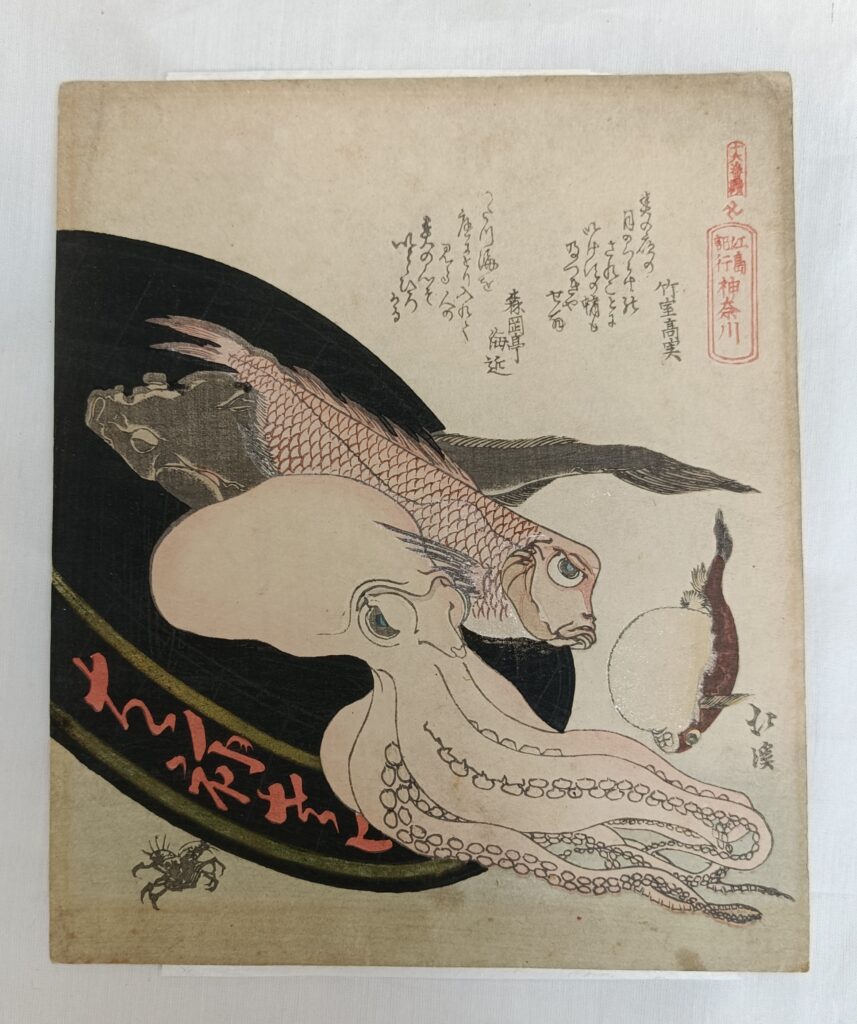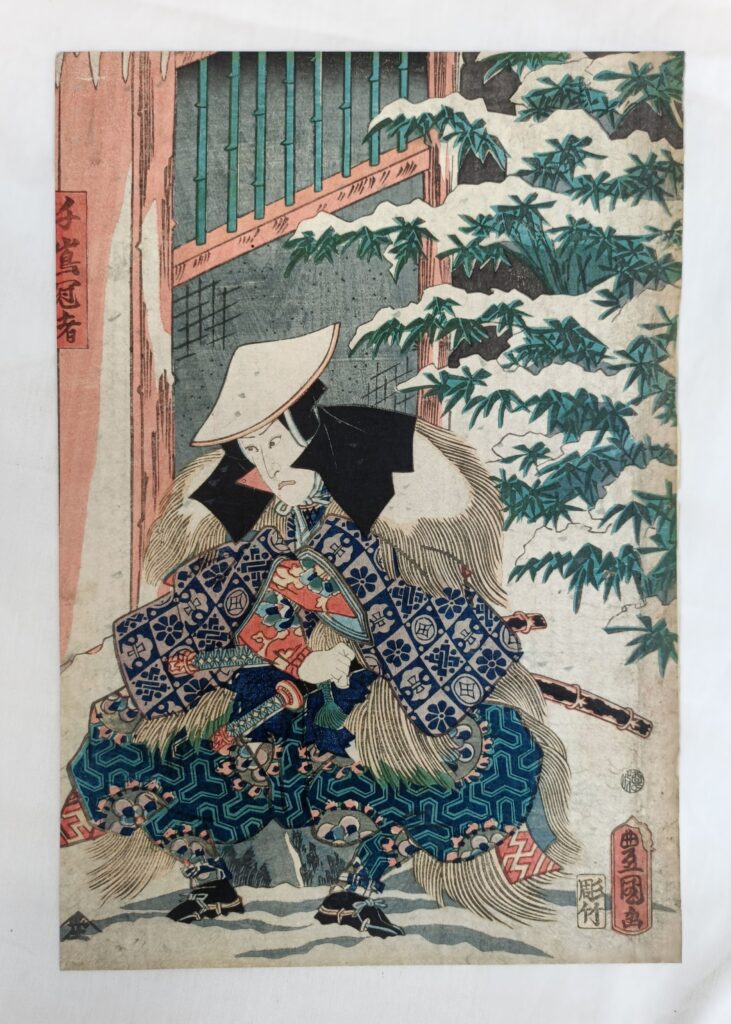Many of our visitors to Cliffe Castle earlier this year enjoyed the exhibition of artwork inspired by or depicting Samurai that we had on display in the Bracewell Smith Hall.
Although the artworks are now safely back in storage, we wanted to be able to share them with you still, so Dale Keeton, our talented conservator, who made it all look spectacular and Ernest, our wonderful volunteer have written this blog to provide some additional insights.
They write:
The art of the Samurai
Ukiyo-e
‘ukiyo’ refers to the floating world of people, and e’ means picture, so these woodblock prints depicted the everyday life of people living in the city of Edo (modern Tokyo).
They illustrate familiar subjects such as kabuki actors, heroic warriors, and beautiful women as well as everyday objects and landscapes. They became a popular art form in the Edo period (1603–1867) due to advances in woodblock printing techniques and partly to the creativity of the Ukiyo-e artists.
Most ukiyo-e were made using woodblocks. At first they used sumi or the black ink used in calligraphy for line work. As demand grew colours were added a technique was developed where the coloured parts could be added by printing.This technique being referred to as nishiki-e (multicolour)
Bijin-ga, Beautiful person picture
Early woodprints often showed the mannerism of famous Courtesans who were seen as celebrities of the day. These portraits reflected the changing standards in beauty as well as the important role women played in Japanese society. The figures are often stylised, with longer necks and a flowing almost serpentine stance.
During the Edo period there was a dress code for everyone in society, but it was very difficult to enforce. It was used to identify social rank and privilege for each individual and by understanding the dress code we are able to interpret the portraits and learn a little more about the person represented in them.
Ukiyo-e can be seen as fashion magazines of their time and would have had illustrated the latest in styles and fashionable textiles.
Courtesan parading with onlookers,

Accession number: 1960 – 031 (13)
In this image, A Shin yoshiiwara or courtesan wears an unusually elaborate hairstyle with many hairpins and bows. The style of hair can be an indication to the age, social class and occupation of the wearer but most styles had a maegami (fringe), bin (side wings), mage (bun) and tabo (loop under the top knot) with a variety of hairpins and combs to help keep everything in place.
Hair worn long and loose in public was usually the reserve of the Empress and her daughters.
Musha-e, Warrior pictures
The Edo period was a time of peace that unified Japan into a single nation. Once warring clans were unified, the samurai found themselves taking on the role of magistrates and fire marshals. They longed to be a part of the heroic battles of their forefathers and turned their attentions to folklores and battles of their forbearers.
Folktales of heroic battles from earlier generations and the daring deeds of battling warriors became a favourite theme for these peace time Samurai and many ukiyo-e artists became skilled in this Genre.
Onikojima Yataro Kazutada

From Eiyu rokkasen, Six Select Heros, 1853, Kuniyoshi (1797 – 1861)
Woodcut on paper Accession number: 1960 – 031(5)
Publisher Hayashi-Ya Shogoro
This is a portrait of the warrior Kojima Yataro Kazutada whose fierceness in battle earned him the nickname Onikojima or Devil Kojima. He stands proudly with the severed head of an enemy in his hand with his back to the viewer and brandishing a polearm. His kabuto (helmet) bears a crab on the front and his Sashimono features and red face demon.
Kacho-e, Birds and flowers
The Tenpo economic reforms of 1841-1843 were an effort to supress outwards expressions including the depiction of courtesans and actors. Consequently, many ukiyo-e artists designed travel scenes and took nature as an inspiration.
Landscapes had always been a popular theme but it was not until the Edo period that artists like Hokusai and Hiroshige took it as a genre of their own. Still life offered an opportunity for an artist to focus their intentions on objects that were commonplace and would have been easily recognisable by many people.
Kanagawa, 1833
Kanagawa is a coastal province and provided Hiroshige with an octopus, red tile fish, pike, globefish and crab as a still life for this print.

Accession number: 1960 – 032(5)
Hiroshige is a master of woodblock printing with over 8000 works attributed to him. Orphaned at 12 he joined the Utagawa school under the tutorage of Toyohiro. His early works are predominantly long narrow landscapes in the style of Chinese scrolls featuring thatched cottages under mountains. Two years before his death he became a monk after publishing his most famous series, One hundred Famous Views of Edo.
His works were collected by Monet, Van Gogh and Whistler and his Bokashi or shading technique have visibly influenced artists like Paul Gaugin.
Yakusha-e, Kabuki actors
Kabuki is a Japanese traditional theatre form that started in the Edo period. Both men and women acted in the plays but eventually it became the domain of only male actors. Some Male actors specialized in women’s roles are called onnagata. Two other major role types are aragoto or rough style and wagoto or soft style.
Plays are about historical events with moral conflict in relationships of the heart. The actors speak in a monotone voice and are often accompanied by traditional instruments. Common attributes of Kabuki theatre are its music, costumes and acting styles in which the actor holds a characteristic pose to establish his characters.
Many actors were easily recognizable by their makeup and stance so are often unnamed on the woodblock prints.
Kawarazaki Gonjuro I as a samurai in the snow 1861.

Accession number: 1960.031(03)
This is a portrait of the actor Kawarazaki Gonjuro I dressed as a samurai sitting outside a country house. He looks downhearted and wears a worried frown with one hand tucked up inside of his sleeve. His mino (straw overcoat) and kasa (straw hat) are covered in snow indicating that he has sat there for some time pondering on deep thoughts.
Utegawa Kunisada was one of the most popular and commercially successful designer of woodblock prints in the 19th century. Towards the end of his career, he changed his name to that of his teacher Toyokuni